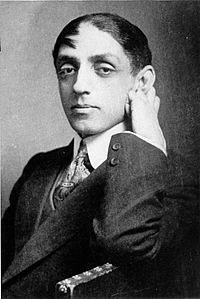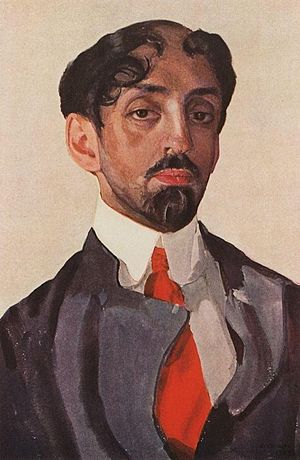Mikhail Kuzmin facts for kids
Quick facts for kids
Mikhail Kuzmin
|
|
|---|---|

Mikhail Kuzmin c. 1911.
|
|
| Born | Mikhail Alekseevich Kuzmin October 18 [O.S. October 6] 1872 Yaroslavl, Russian Empire |
| Died | March 1, 1936 (aged 63) Leningrad, Russian SFSR, USSR |
| Alma mater | Imperial Moscow University (1903) |
| Notable works | Wings |
Mikhail Alekseevich Kuzmin (Russian: Михаи́л Алексе́евич Кузми́н) (October 18, 1872 – March 1, 1936) was a Russian poet, musician, and novelist. He was an important writer during a time called the Silver Age of Russian Poetry.
About Mikhail Kuzmin
Mikhail Kuzmin was born into a noble family in Yaroslavl, Russia. He grew up in St. Petersburg. As a young man, he studied music at the Saint Petersburg Conservatory. His teacher was the famous composer Nikolai Rimsky-Korsakov.
Kuzmin did not finish his music studies. He later said that writing poetry was "easier and simpler." He felt that poetry came to him naturally. Even so, he kept making music. He wrote music for a play called Balaganchik (The Fair Show Booth) in 1906. His songs were very popular in St. Petersburg. He would sing them while playing the piano in fancy places.
One of his close friends was Georgy Chicherin, who loved music by Wagner. Kuzmin was also greatly influenced by his travels. He visited Egypt and Italy, and then northern Russia. He was very interested in the Old Believers, a group of religious people there.
When he settled in St. Petersburg, he joined a group of artists called Mir iskusstva (World of Art). His first writings were published in 1905. A famous writer named Valery Bryusov noticed his work. Bryusov asked Kuzmin to write for his magazine, Vesy (The Balance). This magazine was important for the Symbolist movement.
In 1906, Kuzmin published a series of poems called "Alexandrian Songs." He also published a novel called Wings. This book became very well-known and made him a popular writer. In 1908, his first poetry collection, Seti (Nets), was also very popular. His poems were smart and covered many topics, from ancient Greece to modern St. Petersburg.

Mikhail Kuzmin died in 1936 from pneumonia.
His Ideas on Poetry
Kuzmin was connected to the Symbolist writers, but he also had his own ideas. In 1910, he wrote an essay called "On beautiful clarity." In this essay, he talked about how writers should be clear and logical. He wanted writers to use words carefully and precisely. He called this idea "beautiful clarity" or "clarism."
He was friends with many writers, including Anna Akhmatova. He even wrote a nice introduction for her first book of poems.
Kuzmin's last book of poems published while he was alive was The Trout Breaks the Ice (1929). It was a collection of story-telling poems. In the 1920s and 1930s, he worked mostly as a translator. He translated plays by Shakespeare. He died in Leningrad.
Why His Work Matters
Many people think Kuzmin's work is very important for Russian literature. A poet and critic named Alexei Purin believes that Kuzmin helped Russian writing become more personal and artistic. He says Kuzmin's poetry, along with that of Innokenty Annensky, helped move Russian poetry away from being "like everyone else." They focused on small, everyday details and natural ways of speaking. This was a big change, like the one made by Pushkin.
Another famous poet, Osip Mandelstam, wrote about Kuzmin's work. He said Kuzmin's poems were "captivating" and easy to remember. Mandelstam felt that Kuzmin brought different cultures and music into his poetry. He said Kuzmin's work included "the entire history of European culture insofar as it had become music."
See also
 In Spanish: Mijaíl Kuzmín para niños
In Spanish: Mijaíl Kuzmín para niños

